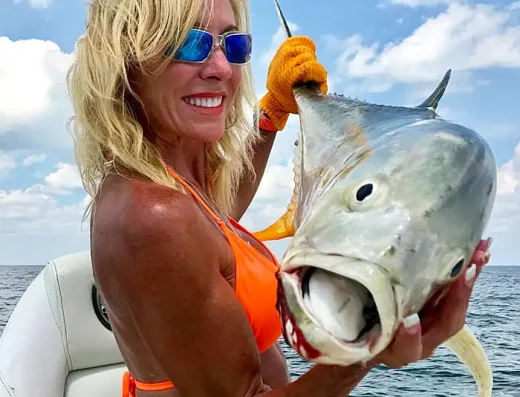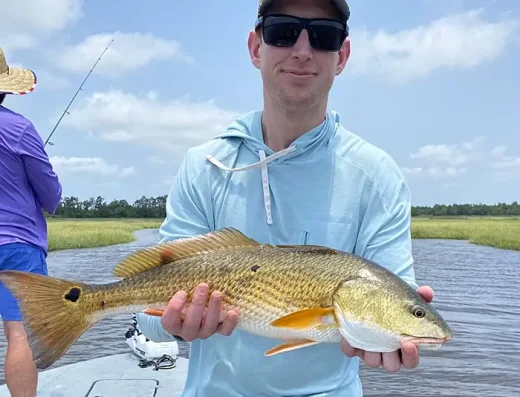Lake Charles Fishing Guides
Lake Charles fishing charters work the Calcasieu Ship Channel, marsh cuts, and Gulf passes for speckled trout, redfish, and flounder.
Top Rated Guides in Lake Charles
TrustedFish connects anglers with proven local captains in Lake Charles, Louisiana —no commissions, no pay-to-play listings, no BS. Every charter on our platform is invite-only, vetted for skill, local knowledge, and reputation. If they’re listed, they’ve earned it.
Lake Charles, LA Fishing Guide
Lake Charles sits on the western edge of Louisiana’s marsh country, with quick access to both the brackish waters of Calcasieu Lake and the open Gulf beyond Cameron. The main fishery is built around the Calcasieu Ship Channel, a deep, well-marked waterway that runs from Lake Charles south through the estuary to the Gulf. Most local guides run half-day and full-day trips, with some specialty runs targeting trophy trout at dawn or night flounder gigs during summer. The lake itself is surrounded by sprawling marsh, with drains, bayous, and oyster reefs that hold fish year-round.
From the public launch at Prien Lake Park or the older city docks, boats can be in prime water within minutes. Runs to the southern end of Big Lake are usually under 30 minutes; heading out the channel to the Gulf jetties takes longer, but it’s worth it when big bull reds and Spanish mackerel are stacked in the tide. Summer can bring nearshore shots at tripletail and even tarpon if the water is right.
The seasonal bite shifts with water temperature and salinity. In spring, trout move onto shallow reefs, and reds prowl the marsh edges. Summer heat pushes many fish deeper into channel drop-offs, while fall sees a flood of bait into the system and some of the best action of the year. Winter trips tend to focus on slower presentations for trout and drum in deep holes and along channel ledges.
Techniques vary—light tackle with live shrimp under a popping cork is a local staple, especially for trout and reds in the marsh. Drifting and bouncing soft plastics works well over shell beds. For flounder, slow-rolling a jig tipped with shrimp along a current seam is hard to beat. Live bait rigs, trolling, and vertical jigging all come into play when fishing the deeper channel stretches.
Fishing Seasons in Lake Charles
Spring (March–May)
Warmer days and rising salinity bring speckled trout onto shell reefs in Big Lake, with redfish thick in the marsh drains. Water clarity improves, making sight-casting possible on calmer days. Most charters run morning trips to take advantage of the best bite before midday sun. Live shrimp under a popping cork is a go-to, but plastics like paddle tails produce when trout are feeding aggressively. Flounder start showing up along sandy channel edges, and black drum move into shallows to feed.
Summer (June–August)
Long, hot days shift the bite deeper. Trout hold along the channel drop-offs and deeper reefs, with some of the best action just after sunrise. Bull reds stage at the Gulf jetties, and tripletail hover near crab trap buoys offshore. Guides often fish early and late to beat the heat, sometimes offering night flounder gigging trips. Live bait reigns supreme, but jigging spoons and swimbaits can trigger strikes from fish holding tight to structure.
Fall (September–November)
Cooling temps and massive bait runs make this the peak season. Specks school up and chase shrimp under birds in open water, while reds smash mullet along the shorelines. The marsh fills with fish following the bait, and anglers can switch between trout, reds, and flounder in the same trip. Charter captains often drift large areas, casting plastics to feeding fish, then anchor to work a productive spot. The bite can last all day with moving water.
Winter (December–February)
Cold fronts slow the action, but patient anglers score on quality trout holding in deep holes and along channel ledges. Redfish push into protected marsh ponds, where they can be caught on slow-worked jigs and live bait. Fewer charters run this time of year, but those that do focus on smaller windows of stable weather between fronts. The water is often at its clearest, which can make the fish spooky—lighter leaders and subtle presentations pay off.
Gamefish in Lake Charles
- Speckled Trout – 14–26 inches. Found on shell reefs, channel edges, and under birds in open water; peak in spring and fall on live shrimp or plastics.
- Redfish – 16–40 inches. Marsh drains, flats, and jetties; year-round, with bull reds strongest in summer and fall.
- Flounder – 12–20 inches. Channel edges and sandy flats; best in spring and fall on jigs tipped with shrimp.
- Black Drum – 16–40 inches. Deep holes and channel ledges; winter and early spring on shrimp or crabs.
- Tripletail – 10–25 pounds. Near buoys and surface structure offshore in summer; caught on live shrimp or small jigs.
- Sheepshead – 12–20 inches. Around pilings and rocks; peak in winter and early spring on fiddler crabs or shrimp.
- Spanish Mackerel – 14–24 inches. Near Gulf passes and jetties in summer; caught trolling spoons or casting metals.
Lake Charles Fishing FAQs
What are the main launch points for fishing trips in Lake Charles?
Most charters launch from Prien Lake Park, the Calcasieu Point Landing, or docks along the ship channel in town. These locations allow quick access to both Big Lake and the Gulf runs.
How long are typical fishing trips in Lake Charles?
Half-day trips usually run four to five hours, while full-day charters go seven to eight hours. Specialty trips, like night flounder gigging, may run shorter but target specific species.
Do charters provide fishing gear in Lake Charles?
Yes, most guides supply rods, reels, tackle, and bait. They also bring necessary safety equipment, though anglers may bring personal gear if preferred.
Is a fishing license required for charter trips in Lake Charles?
Yes, all anglers 16 and older need a Louisiana fishing license, and a saltwater endorsement is required when fishing Big Lake and beyond. Licenses can be purchased online or at local retailers.
What’s the best time of year to fish Lake Charles?
Fall offers the most consistent action across species, with big trout, schooling reds, and plenty of flounder. Spring also produces well, especially for trophy trout.
What fishing techniques work best in Lake Charles?
Popping cork rigs with live shrimp are a top choice for trout and reds in the marsh. Soft plastics and jigging spoons excel over reefs and in deeper channels.
Can families with kids fish comfortably in Lake Charles?
Yes, the protected waters of Big Lake are ideal for shorter trips with children, and captains can tailor the trip to calmer spots and easy bites.
What species can be caught near the Gulf from Lake Charles?
Near the jetties and passes, anglers often catch bull reds, Spanish mackerel, tripletail, and occasionally tarpon in summer.
Do guides offer specialty trips out of Lake Charles?
Some captains run night flounder gigging trips in summer, while others focus on trophy trout hunts at first light during spring and fall.


